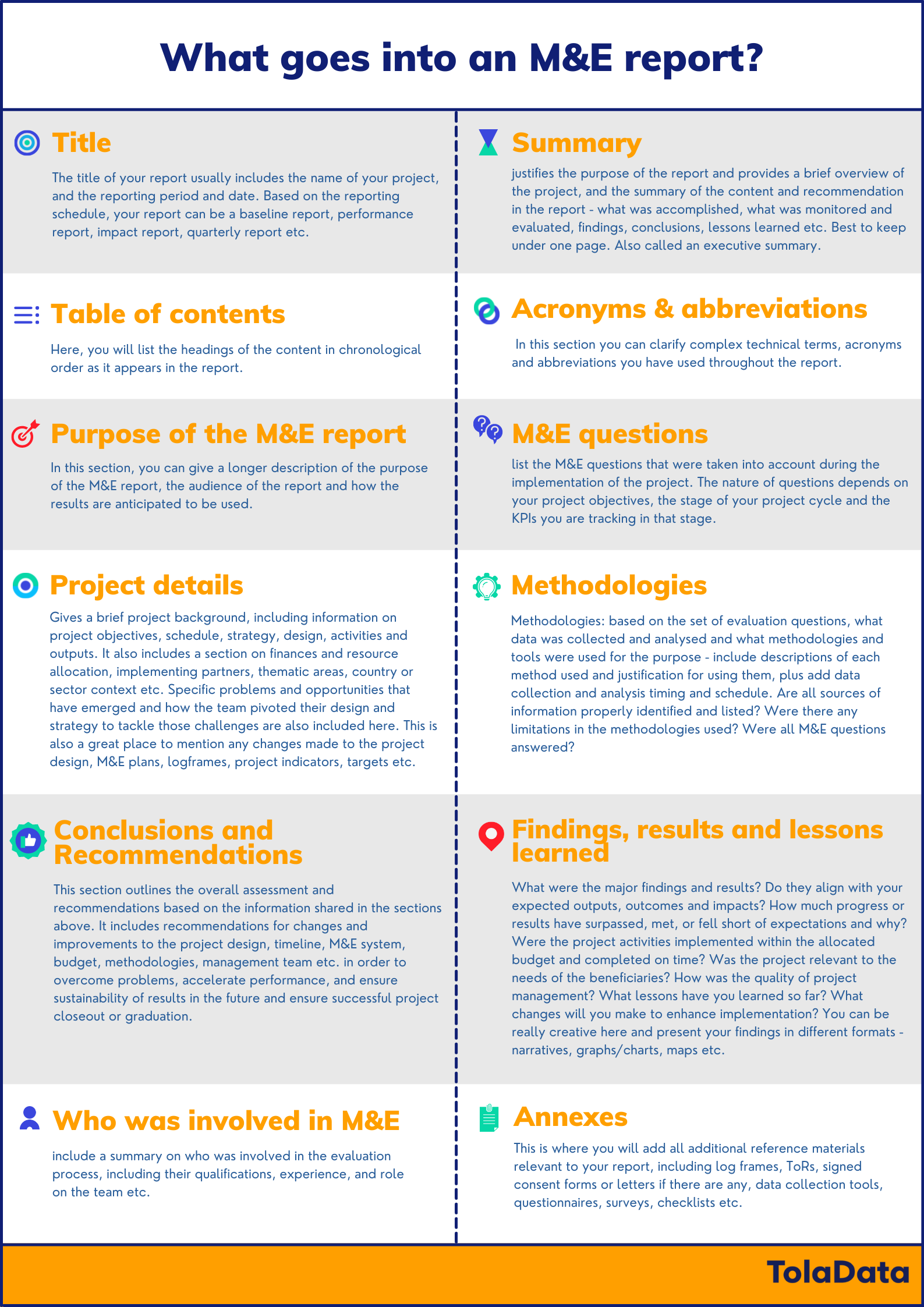How to write a good monitoring and evaluation report - guidelines and best practices
July 27, 2021
Reporting is an integral part of any monitoring and evaluation plan or framework. Good reporting enables organisations to communicate the value of their work and their impact while allowing them to demonstrate aid effectiveness and enhance performance, collaboration, learning and adaptation within their organisation and throughout the entire project cycle.
In this article, we will explain what monitoring and evaluation reporting is, how it’s done and how your organisation can benefit from periodic reporting. Plus, stay with us as we walk you through some of the best practices of M&E reporting – M&E report formats and frequency, what to include in your M&E report and some top guidelines from experts to help you streamline your reporting process and write reports that are credible and constructive.
What is monitoring and evaluation (M&E) reporting and how is it done?
Reporting is the documentation and communication of M&E results to appropriate audiences at specified times. The key purpose of reporting may be to account for funds expended, to provide rich data for the decision-making process or to improve targeting and coordination of investments and on-ground actions. Reporting can be done at a project or program level. Most M&E reports include financial summary of a project as well as updates on its progress and achievements, activities undertaken, inputs supplied, money disbursed, key findings, results, impacts, plus, conclusions and recommendations from the interventions that have been compiled from various monitoring and evaluation activities and data sources.
The goal of reporting is to present these collected and analyzed data as information or evidence to key stakeholders and investors to utilize and to increase their confidence in the project and the implementing team.
Benefits of periodic monitoring and evaluation (M&E) reporting
Periodic reporting on M&E data helps internal staff and management teams to assess and communicate their transparency and accountability to their stakeholders, partners, funders, beneficiaries and others. It enables them to identify and interpret the progress their interventions have made against their set targets and indicators and its impact in the community of interest and its people.
M&E reports also help the team to test the effectiveness of their underlying assumptions, project activities, design, strategy and suggest ways for future adaptation and improvements. Moreover, M&E reports allow the team to identify and share challenges they have encountered, unexpected changes that have emerged in the process, along with underlying reasons for under-performance or shortcomings of existing management and monitoring systems and their proposed recommendations and action plans for improvements of subsequent work plans and sustainability of their results.
M&E reports help the stakeholders, partners, donors and others involved in the project to grasp a clear picture of the performance of the project and its real impact on the ground, helping them make evidence-based decisions to improve the current intervention and design better projects in the future. These reports also help the higher-up management teams to make adjustments to their internal operations and make recommendations for the state or country level policy amendments. Moreover, the evidence from such reports also help the donors to direct aid and funding to where it’s needed most – to address the most critical issues and help the most vulnerable communities in need.
Monitoring and Evaluation (M&E) reports - frequency and formats
Each organisation is different and so are its projects, hence every organisation has its own unique reporting system. M&E reports can be produced and distributed on a weekly, bi-weekly, monthly, quarterly, bi-annually or on an annual basis. Weekly and bi-weekly reports are usually concise and shared with the internal team and some external stakeholders to keep them up to date on the project progress against their targets, budget, any changes made to the project or the implementing team etc. However, monthly, quarterly bi-annual or annual reports are much more comprehensive and include more details and evidence on the progress of the intervention, project inputs, activities, outputs, outcomes, lessons learned, recommendations etc. These are shared with a wider audience, including partners, donors and other stakeholders.
Many organisations report on their M&E data in a traditional narrative format in the form of paper reports. However, with the emergence of digital technology and approaches, many others are adopting new and innovative mediums to report, such as videos, recorded audio, interactive media, mapping, data visualization, interactive dashboards, online presentations and more. How often and in which format reports are produced and distributed depends on the organisation and its reporting system. The frequency and format also depend on the nature of the project, its M&E plan and log frames, the resources available, the requirements of the donors and the audience of the report – how and by whom reporting data will be utilized etc.
Note that many organisations report on their monitoring and evaluation activities together, however, there are exceptions. In some organisations, monitoring and evaluation reporting is done separately. Monitoring is done by implementing staff members and it’s undertaken more frequently than evaluation. Evaluation on the other hand could be undertaken by internal staff or external consultants.
See how TolaData’s configurable dashboards can add value to your organisation’s reporting processes.
Some key points to keep in mind before writing your M&E report
- Have you identified indicators for each project activity? Indicators must be relevant and easy to track, measure and report. Here’s how to create indicators that make sense.
- Have you identified key monitoring and evaluation questions and determined what data will need to be collected and which tools and methods will be used to collect them?
- How will you collect, consolidate and analyse your data and distil insights from it? Here’s how you can integrate data from multiple sources and tools.
- How will you compile and consolidate the findings and results and include them in your report?
- How frequently will you send out your report and in what format?
- Be mindful of the audience and timing of your report. M&E reports are effective only when they are submitted to the right people at the right time and facilitates corrective decision making.
What goes into an M&E report?
Please note that this list includes some common elements included in an M&E report. As mentioned above, every organisation and every project is different and so is their reporting system. Therefore, you will have to adjust this list according to the nature of your project, the requirements of your donors and stakeholders and the audience of your report.

This list has been adapted from the Evaluation Report Checklist by USAID.
Guidelines for writing credible and constructive monitoring and evaluation (M&E) reports.
The following guidelines have been adapted from the document – Monitoring and Evaluation Guidelines from the UN World Food Programme.
- To help ensure efficiency, the purpose of reporting should be clearly defined. Be sure to include a section in the introduction describing the need to produce this report and its anticipated use.
- Make sure the information you are providing is accurate, complete, reliable, timely, relevant and easy to understand.
- Be clear who your audience is and ensure that the information is meaningful and useful to them. If needed, tailor the content, format and timing of the report to suit the audiences’ needs. Information is of little value if it is too late or infrequent for its intended purpose.
- Consistency is key. Reporting should adopt units and formats that allow comparison over time, enabling progress to be tracked against indicators, targets and other agreed-upon milestones.
- Make sure your report is concise and the layout clean and consistent.
- Focus on results and accomplishments and link the use of resources allocated to their delivery and use.
- Be sure to include a section describing the data sources and data collection methods used so that your findings are objectively verifiable.
- Write in plain language that can be understood by the target audience. Avoid complex jargons and details if possible and be consistent in your use of terminology, definitions and descriptions of partners, activities and places. Be sure to define any technical terms or acronyms in the annex section.
- Make use of graphs and charts to communicate your findings. Present complex data with the help of figures, summary tables, maps, photographs, and graphs that are easier to understand.
- Include references for sources and authorities.
- Include a table of contents for reports over 5 pages in length.
- Make sure your reporting system is cost effective. Avoid excessive, unnecessary reporting. Information overload is costly and can burden information flow and the potential of using other more relevant information.
- Be open to feedback. Make sure to include an email address, a physical address or a telephone number for the recipients to send their feedback on the report.
As we can see, there are many benefits of good and timely reporting and it should be a part of every development project and its monitoring and evaluation system. However, many organisations continue to report on their progress only as a part of the donor requirement, without giving much heed to the huge prospect of collaboration, learning, adaptation and improvement. Therefore, a good reporting system should have a balance of all these elements, plus quality project management and good coordination and communication flow within the team.
We hope you found our article helpful. If you have any comments or suggestions on how we can improve it, please leave a comment below.
Key References
By Chandani Lopez Peralta, Content Marketing Manager at TolaData.


Thank you very much for the useful information
Our pleasure, Hassani. So glad to hear that you found our article helpful. Do check our Blog section for more resources on M&E — https://www.toladata.com/blog/
thank you so much just checked it out, you guys are doing a great job and now you have made my job much easier. Jackpot here!
Good work
I like the simplicity of explanations and clarity on topics.
Best wishes
Thank you for your lovely comment, Benedicta!
This document is quite enriching and had greatly enhanced my reporting skills.
From now henceforth my reports will be much more improved and quite concise.
Glad to be of help, Mercy! In case you are looking for more insightful resources on M&E related topics, do check out our blog section – https://www.toladata.com/blog/
Thank you very much. I have found your articles very enlightening. Do you have any on how to budget for M&E? Also is M&E reported separately from the report produced by project officers or both are merged
Thank you for your feedback, Amina! To answer your question, it depends on your donor’s reporting requirements. Some choose to report on M&E activities separately while others merge them with their project reports. We do not have a separate article on budgeting for M&E yet but we will definitely add that to our list.
Thanks a lot. I realized how M&E is important and how useful for us.
Glad to hear that, Thein Zaw!
This was helpful and enlightening
Thanks
I really love this write-ups.
Thank you so much.
I realized that M&E report is the best
Thanks alot
When evaluating project management software, it is important to consider the compatibility of the software with your current project management process.
very helpful
Thank you so much, content is so informative
thanks its very intersting
I have an inquiry, for the report conclusion, do we need to support this section with numbers or percentages or no need!!
Thank so much for the resources it actually help a lot
thank you for your assistance it has helped me alot